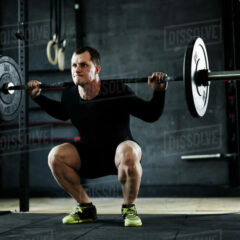https://weightliftingforpower.com/recovery-strategies-after-intense-great-tricep-workouts/
Recovery Strategies After Intense Great Tricep Workouts
It’s essential to appreciate the strength and endurance that our triceps provide. These muscles, making up about two-thirds of your upper arm, do much heavy lifting daily. They’re key players in pushing movements, like when you’re doing a bench press or just pushing open a heavy door. In these movements, the triceps extend the elbow joint, essential for pushing objects away from the body. But putting these muscles through intense workouts can lead to strain if not appropriately managed.

Some individuals may fall into common traps, such as neglecting proper form or overloading too quickly. These mistakes cannot only hinder progress but also lead to discomfort or injuries, which is something we all want to avoid. Recognizing pain beyond regular post-workout soreness is crucial. Pain is your body’s way of waving a red flag. If you feel pain in your triceps instead of just soreness, it may indicate a more serious issue that requires attention. This awareness can keep you cautious and attentive to your body’s signals.
Here’s some advice: listen to your body after those tough sessions. You’ll likely experience muscle fatigue or temporary stiffness, but be mindful of lasting pain or swelling. For instance, if you experience persistent pain in your triceps even after a few days of rest or notice significant swelling that doesn’t subside, these could be signs of a deeper issue. Identifying these signs early can protect you from sustaining more severe injuries down the line.
Listen to stories. I’ve heard gym-goers talk about getting sidelined because they didn’t pay attention to these cues. A friend shared how they ignored early signs of strain and kept pushing hard, thinking it was just normal soreness. This led to a really tough recovery path that could have easily been avoided.
Understanding these impacts helps in planning effective workout regimes and emphasizes the need for proper recovery strategies. Knowing when to rest, when to push, and how to cater to your muscles is all part of an innovative training program.
Immediate Post-Workout Recovery Techniques
Wrapping up an intense tricep session, consider cooling down as your first step toward recovery. Stretching right after your workout can help prevent those muscles from getting too tight and reduce the risk of injury. Even a few minutes spent on a mix of static and dynamic stretches can make a big difference.
Keeping hydrated is good for general health and vital for muscle recovery. After a tough session, your body’s likely lost a good amount of fluids, so drinking water aids in muscle repair and overall recovery. Plus, it helps flush out toxins that build up after intense physical activity.
Once you’ve cooled down and rehydrated, foam rolling or a massage could be your next best friend. This isn’t just a luxury; it’s a practical technique to ease muscle knots and improve circulation, which helps keep soreness at bay. A 10-minute routine with these tools can really help those triceps recover faster.
There’s some interesting debate about whether to choose active recovery—staying somewhat active with light exercises—or passive recovery, which is basically taking the complete rest route. Active recovery could mean a light walk or yoga, which keeps your blood flowing without overworking your muscles. Passive recovery is an essential strategy that allows your muscles to recuperate without added stress. By prioritizing complete rest, you allow your body to heal and rejuvenate effectively. Understanding what works for you can be a game-changer in your recovery strategy.
These techniques aren’t just random tips; they’re the foundation of keeping your triceps happy and strong, ready to face the next challenge without setbacks. By prioritizing immediate recovery, you’re setting the stage for more efficient workouts and fewer injuries ahead.
Nutrition and Supplements for Optimizing Tricep Recovery
Fueling up right after your workout can significantly boost your recovery. Your muscles need specific nutrients to repair and grow, so focusing on what you eat post-exercise is key. Protein is the star here; it plays a vital role in muscle repair. Consider lean meats, fish, eggs, or plant-based options like tofu and legumes to get your fix. Grasping the significance of these nutrients can empower you to make informed decisions that effectively support your muscle rebuilding efforts.
Carbohydrates often get a bad rap, but they’re crucial post-workout. They help refill energy stores, mainly glycogen, that your muscles use during those intense sets. Think whole grains, fruits, and starchy veggies to replenish your energy levels effectively.
Adding supplements to your regimen can significantly improve your recovery, especially when you struggle to get enough nutrition from your diet alone. Consider supplements as a valuable tool to help you achieve your wellness goals! Protein shakes offer a convenient solution for your dietary needs, and incorporating branched-chain amino acids (BCAAs) can significantly enhance muscle recovery and alleviate soreness effectively. Creatine is another supplement worth considering for supporting muscle energy and growth.
Take inspiration from real-world diets that support recovery. Some athletes share their go-to meals, which often balance protein, carbs, and fats. Many find that meal timing also matters, usually aiming to eat within one hour post-workout for optimal benefits.
These nutritional strategies are not just about quick fixes but about building a consistent approach to eating that supports ongoing muscle recovery and overall health. Attention to food and supplement choices can transform your recovery process and enhance your performance.
Enhancing Long-Term Recovery and Prevention Strategies
Maintaining your triceps isn’t just about what happens at the gym. It’s just as much about what you do outside of it, especially regarding recovery and injury prevention. Rest days are your friend, not a foe. Giving your body the chance to repair itself is crucial for long-term athletic success. Don’t underestimate the power of sleep, either—it’s the ultimate game-changer. Your body does its best to recover while snoozing, repairing, and building muscle strength.
Keeping your workouts balanced is crucial to preventing overuse injuries. Sometimes, pushing through intense workouts back-to-back can be tempting, but over time, it’s likely to backfire. Mixing different types of exercises ensures you’re not overworking a particular muscle group, which is really important for your triceps. This emphasis on balance can make you feel mindful and responsible in your workout choices.
Mental health is a vital factor that significantly influences physical performance and recovery. Prioritizing mental well-being can enhance athletic abilities and lead to more effective recovery outcomes.. Stress isn’t just a state of mind; it has physical effects that can hinder recovery and performance. Taking steps to manage stress can be as impactful as your physical strategies.
Athletes who successfully incorporate recovery and prevention strategies often share a few similarities: They listen to their bodies and prioritize recovery as much as their workouts. Their stories highlight how staying in peak condition is possible while avoiding the setbacks that come with overtraining or injury. Emulating these practices can help you set realistic and sustainable goals for your fitness journey.

This is an absolutely fantastic and comprehensive guide! As someone who’s been trying to break through a plateau in my upper body strength, the variety of exercises you’ve detailed here is exactly what I needed. I particularly appreciate how you didn’t just list the movements but explained the why behind them,especially the focus on targeting all three heads of the tricep for complete development.
The inclusion of the close-grip bench press and the overhead cable extensions is spot on. I’ve found that combining a heavy compound movement with high-rep isolation work, just as you’ve structured it, leads to the best results in both strength and muscle definition. I’m excited to integrate the “skull crusher to press” complex into my next push day; it looks like a brutal but incredibly efficient way to build power.
Thanks for putting together such a valuable, no-fluff resource. It’s clear a lot of knowledge and practical experience went into this. I’ve already bookmarked it for regular reference!
Thanks for the feedback , remember rest days from a brutal workout will enhance your growth and health muscles!